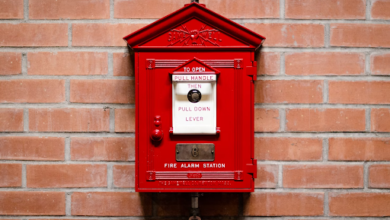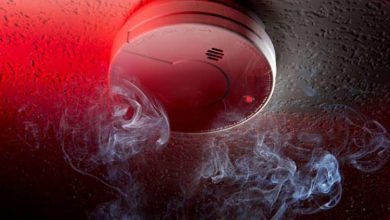What Does The Red Light On A Smoke Alarm Mean?
KEY TAKEAWAYS
Collaborative efforts can help reduce house-fire-related deaths, making them as rare as some vaccine-preventable diseases.[1]
Smoke alarms were present in 74% of reported home fires, and nearly three out of five home fire deaths occurred in properties with no smoke alarms or non-working smoke alarms.[2]
It is estimated that if every home had working smoke alarms, U.S. residential fire deaths could drop by 36%, potentially saving around 1100 lives per year.[3]
Smoke detectors, also known as smoke alarms, play a crucial role in home safety by detecting the presence of smoke caused by fire. These devices contain sensors designed to react to particles in the air from a fire, sounding an alarm that can be heard throughout the building or home where they are installed.
This early detection is vital, as collaborative efforts in fire safety, much like those in public health for vaccine-preventable diseases, can significantly reduce house-fire-related deaths.[1] Smoke alarms alert you to the presence of smoke in your home, detecting fires that can be deadly if not identified promptly. When they go off, it’s a clear signal to evacuate and seek help, underscoring the importance of these devices in safeguarding lives and property.
Fast Facts
The red light on the smoke alarm means that there is a problem with your battery.
What the Red Light on Smoke Alarms Indicate
A working smoke alarm is one of the best ways to protect yourself and your family from fire-related injuries or death. That’s why you should have them installed in every room of your house. Different kinds of smoke alarms work best for different spaces in your home.
The red light on the smoke alarm means that there is a problem with your battery. You should replace your batteries every six months for optimal protection from fires and other hazards in your home. Smoke alarms need the power to work correctly.
Battery Replacement
The main reason for the red light is an indication that the battery needs to be replaced. However, it can happen for two reasons; either the battery has reached its end of life or has not been installed correctly.
If this happens, replace the battery as soon as possible and test your smoke alarm by pressing any button on it. If you hear a loud sound, then everything is working correctly. It is important because a faulty fire alarm can lead to massive fires.
If you have an ionization detector built into your smoke detector, the red light indicates that it needs to be replaced. Ionization detectors are more sensitive and will activate earlier than photoelectric detectors when exposed to smoke or fire.
Understanding Smoke Detector Technology
How Smoke Detectors Work
Smoke detectors, vital for home safety, come in two types: ionization, sensitive to flaming fires, and photoelectric, quick to detect smoldering fires. Notably, 74% of reported home fires had smoke alarms, yet nearly 60% of fire deaths occurred where alarms were absent or non-functional.[2] This highlights the importance of not just having these detectors but also ensuring they are operational, emphasizing their crucial role in fire safety and prevention.
Cost and Consumer Preferences
The cost of smoke detectors varies, typically ranging from $10 to $50, depending on features like smart connectivity and dual-sensor technology. Consumers often look for reliability, ease of maintenance, and features like long battery life and loud alarm signals. An effective smoke alarm should have a clear and loud signal, ensuring immediate awareness in case of fire.
Significance of Alarm Signals
Different alarm signals in smoke detectors can indicate various statuses, each critical for fire safety in homes. A consistent loud beep usually signals smoke detection, while a chirping sound often points to a low battery. A flashing red light might indicate normal operation or a need for maintenance, depending on the model.
Understanding these signals is crucial, as it’s estimated that if every home had working smoke alarms, U.S. residential fire deaths could drop by 36%, potentially saving around 1,100 lives per year.[3] This statistic underscores the importance of not only recognizing these alarm signals but also ensuring that smoke alarms are always in working order.
Fast Facts
U.S. residential fire deaths could drop by 36%, potentially saving around 1,100 lives per year.
Step-by-Step Guide to Installing and Disabling Smoke Alarms
Installing Smoke Alarms
- Choose the Right Location: Install smoke alarms on every level of your home, including the basement and sleeping areas. Avoid placing them near windows, doors, or ducts where drafts might interfere with their operation.
- Mounting the Alarm: Use the mounting bracket that comes with the alarm. Drill holes in the ceiling or wall, then secure the bracket with the provided screws.
- Insert Batteries: For battery-operated models, insert batteries, ensuring they are properly fitted, and the polarity is correct.
- Attach the Alarm: Align the smoke alarm with the bracket and twist to lock it in place.
- Test the Alarm: Press the test button to ensure it’s working. You should hear a loud beep or alarm sound.
Disabling Smoke Alarms
- Turn Off Power: For hardwired models, turn off the power at the circuit breaker.
- Remove the Alarm: Twist the alarm off its mounting bracket. For hardwired models, disconnect the power cable.
- Remove Batteries: For battery-operated alarms, open the battery compartment and take out the batteries.
- Press the Test Button: After removing batteries or disconnecting power, press the test button to discharge any remaining power.
- Store Safely: If you plan to reuse the alarm, store it in a dry, safe place. If disposing, check local regulations for proper disposal methods.
Fast Facts
Test alarms monthly and replace batteries annually, or choose models with sealed 10-year batteries for less frequent maintenance.
Expert Tips for Smoke Detector Maintenance
- For Homeowners: Choose dual-sensor smoke detectors for comprehensive coverage against all types of fires. Regularly test alarms monthly and replace batteries annually, or opt for models with 10-year sealed batteries for less frequent maintenance.
- For Office Owners/Renters: Ensure compliance with local fire codes by installing interconnected smoke alarms for synchronized alerts across large spaces. Consider smart smoke detectors for remote monitoring and alerts, especially in unoccupied properties. Always consult with a fire safety expert to tailor your smoke alarm system to the specific needs of your office space.
FAQs
1. How do you change the batteries on the first smoke and carbon monoxide alarm?
The smoke and carbon monoxide alarm is battery-operated, so you don’t need an electrician for installation. It requires just two AA batteries and features an easy-access battery compartment for quick changes that will let you change the battery in seconds.
2. What are some ways to prevent electrical hazards from home appliances?
Some tips on preventing hazards from home appliances are: keep your home appliances dry, safeguard your electric outlets, switch off any appliances not being used, and leave the repairs to the experts.
3. How often should I test my smoke alarms, and what is the process?
It’s recommended to test your smoke alarms at least once a month. To test, simply press and hold the test button on the alarm. You should hear a loud, clear beep or alarm sound, indicating it’s working properly. If the sound is weak or nonexistent, it’s time to replace the batteries or the alarm itself. Regular testing ensures your alarms are ready to alert you in case of fire.
Conclusion
Understanding and maintaining your smoke alarms is vital for ensuring safety in your home or office. Regular testing, correct installation, and being aware of the different types and signals of smoke detectors can significantly enhance fire safety. Stay informed, stay prepared, and remember that a well-maintained smoke alarm is a key line of defense in protecting lives and property from fire hazards.
To know more about the basics of fire safety, visit us at Security Forward.
- “Smoke Alarms and Prevention of House-Fire—Related Deaths and Injuries.” PMC, NCBI, 29 Nov. 2023, https://www.ncbi.nlm.nih.gov/pmc/articles/PMC1071009/.
- “Smoke Alarms in US Home Fires Report.” NFPA, 31 Jan. 2021, https://www.nfpa.org/education-and-research/research/nfpa-research/fire-statistical-reports/smoke-alarms-in-us-home-fires.
- “Smoke Alarm Research.” NIST, 10 Jan. 2011, https://www.nist.gov/el/smoke-alarm-research.


